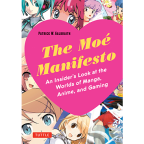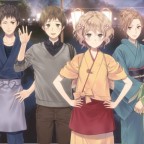Anime’s Influence On The Japanese Society
I’ve recently been approached by a second year M.A. student who decided to include a manga analysis in his upcoming thesis work. Although I am by no means a “know-it-all” in the field I did write my own thesis paper on manga and was happy to help him with some questions he had. One of his questions in particular struck me as interesting and I wanted to share it with you here. That question was “do you know of any instances in which manga influenced the Japanese society?”
To which I answered that while there have been many manga series that garnered large attention from the Japanese populace throughout the years my opinion as a researchers is that manga is an entertaining medium while anime is a critical medium. I went on to explain that the most influential manga series (and manga artists) are those that influenced the artistic imagery of manga. Artists like Clamp and Takahashi Rumiko which were responsible for creating the visual style most shounen and shoujo manga use to this day, or Akamatsu Ken who reintroduced the ahoge to a new generation of manga fans.
Later that day I reconsidered what I said to him in my head again and again. I strictly believe in what I had told him about manga. In the past there have been some manga series that criticized the most sacred institutions of Japan’s society. Manga like Harenchi Gakuen that criticized the Japanese educational system or the Aum Shinrikyo manga that undermined the hegemony of the Japanese emperor. There have been cases of obscene manga that were the cause of public outrage, such as the case of Honey Room (Misshitsu) – a manga so obscene its artist was sentenced to pay a fine of 1.5 million yen and had all his manga series removed from store shelves and confiscated. There have also been cases of controversial manga, such as Afghanis-tan – a manga which put to laughter international conflicts by portraying Arabic countries as moe characters. While all of these manga series had their moment under the spotlights their respective cases were quickly resolved and they were forgotten. This convinces me that manga, albeit being a popular entertainment medium in Japan, has yet to influence the Japanese society in any way that is not commercial.
But merely disapproving manga’s ability to serve as a critical medium does not prove that anime has that ability. It was after I answered his question that I began to look, within my own knowledge about anime, for those series that had a major impact on the Japanese society.
The anime series that has had the most profound impact on the Japanese society until today is probably Neon Genesis Evangelion. This series is popular enough today that I need not introduce it here. Suffice to say that it proved extremely popular in Japan. It was this popularity itself that influenced the Japanese society in a significant way – Neon Genesis Evangelion was not only popular among the ardent otaku but also drew attention from the general public. It caused many casual TV viewers who had not seen anime before to acknowledge it as a valid medium of expression. Evangelion did to casual TV viewers exactly what Studio Ghibli did to causal movie goers – proved that Japanese animation is capable of reaching high intellectual levels and touching mature subjects.

There have been other series that influenced the Japanese society, albeit in more delicate and specific ways. Hikaru no Go – a series about young and talented boys playing the traditional Japanese board game go – created a “go boom” in Japan. It exposed many children (and some adults) to the charms of go and invigorated this old sport. Nodame Cantabile – a series about talented musicians – brought forth a “classic music boom” (although one can make the argument that classic music has always been popular in Japan). Both series, it should be noted, were first published as manga. But although their manga counterparts were popular the anime series, which aired on prime time, reached a much bigger audience and had a much more profound influence. This should come as no surprise as both these anime series provided incentives that could not be found in their respective manga: Hikaru no Go had an educational extra at the end of each chapter that taught the basics of go. Nodame Cantabile’s incentive was even greater. Viewers who watched the series were able to listen to the songs being played, something that the manga could not provide.
If we stray from the realm of anime there are records of a much earlier animated series that had a similar impact on the Japanese society. In the 1960s the animated cartoon Popeye was very popular in Japan. In the show one of the characters, a gluttonous guy called wimpy, was shown eating hamburgers, singing about them and fantasizing about them. Since hamburgers were nonexistent in Japan at the time the Japanese viewers were particularly fascinated by this culinary treat. The hamburgers shown in Popeye caused an unprecedented demand for hamburgers in Japan and many restaurants and foods stands rose to the occasion and added hamburgers to their menus. These hamburgers were not your typical beef patties. During the 60s beef was rare, expensive and most Japanese have never tasted it before. So instead of offering beef the Japanese restaurants and food stands made hamburger using ground fish meat (and later whale meat).

Returning to the issue at hand, perhaps the most unique influence anime has had over the Japanese society can be seen in the seamless way in which anime has integrated into the Japanese culture. Show me a Japanese kid who doesn’t know about Pokemon, a teenager who hasn’t heard the opening theme song from Dragon Ball Z or an adult who doesn’t think My Neighbor Totoro is an indispensable part of the Japanese culture and a reminder of Japan’s agricultural past. Anime Influences the Oricon music chart because a small, yet noticeable, number famous singers and bands (such as Mizuki Nana and Garnet Crow) gained their popularity though their involvement in anime. Anime even occasionally influences the type of merchandise sold in convenience stores and food chains. You can be sure that convenience stores and food chains pay close attention to the popularity of anime series and strike deals to promote their products or brands using anime related goods or branding. Seeing “anime themed” convenience stores (that sell products with covers or drawings from one specific anime) has become very common and once in a while you do see a familiar shounen jump character smiling at you from the banner of one of the big food chains’ restaurants.
Since popularity usually translates into attention and attention in turn can become influential there will be plenty of opportunities for anime to attract attention from the Japanese society and influence it in the future.


















